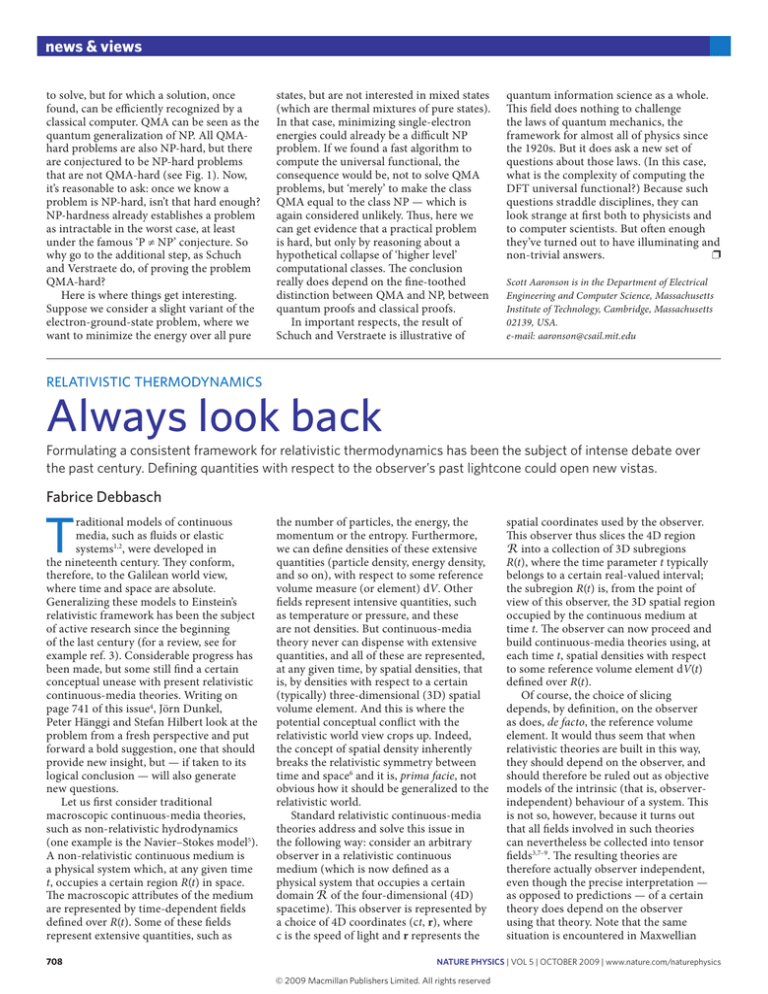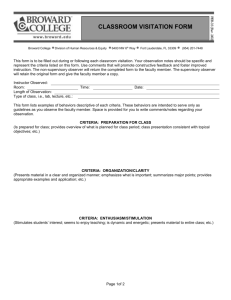
news & views
to solve, but for which a solution, once
found, can be efficiently recognized by a
classical computer. QMA can be seen as the
quantum generalization of NP. All QMAhard problems are also NP-hard, but there
are conjectured to be NP-hard problems
that are not QMA-hard (see Fig. 1). Now,
it’s reasonable to ask: once we know a
problem is NP-hard, isn’t that hard enough?
NP-hardness already establishes a problem
as intractable in the worst case, at least
under the famous ‘P ≠ NP’ conjecture. So
why go to the additional step, as Schuch
and Verstraete do, of proving the problem
QMA-hard?
Here is where things get interesting.
Suppose we consider a slight variant of the
electron-ground-state problem, where we
want to minimize the energy over all pure
states, but are not interested in mixed states
(which are thermal mixtures of pure states).
In that case, minimizing single-electron
energies could already be a difficult NP
problem. If we found a fast algorithm to
compute the universal functional, the
consequence would be, not to solve QMA
problems, but ‘merely’ to make the class
QMA equal to the class NP — which is
again considered unlikely. Thus, here we
can get evidence that a practical problem
is hard, but only by reasoning about a
hypothetical collapse of ‘higher level’
computational classes. The conclusion
really does depend on the fine-toothed
distinction between QMA and NP, between
quantum proofs and classical proofs.
In important respects, the result of
Schuch and Verstraete is illustrative of
quantum information science as a whole.
This field does nothing to challenge
the laws of quantum mechanics, the
framework for almost all of physics since
the 1920s. But it does ask a new set of
questions about those laws. (In this case,
what is the complexity of computing the
DFT universal functional?) Because such
questions straddle disciplines, they can
look strange at first both to physicists and
to computer scientists. But often enough
they’ve turned out to have illuminating and
non-trivial answers.
❐
Scott Aaronson is in the Department of Electrical
Engineering and Computer Science, Massachusetts
Institute of Technology, Cambridge, Massachusetts
02139, USA.
e-mail: aaronson@csail.mit.edu
RELATIVISTIC THERMODYNAMICS
Always look back
Formulating a consistent framework for relativistic thermodynamics has been the subject of intense debate over
the past century. Defining quantities with respect to the observer’s past lightcone could open new vistas.
Fabrice Debbasch
T
raditional models of continuous
media, such as fluids or elastic
systems1,2, were developed in
the nineteenth century. They conform,
therefore, to the Galilean world view,
where time and space are absolute.
Generalizing these models to Einstein’s
relativistic framework has been the subject
of active research since the beginning
of the last century (for a review, see for
example ref. 3). Considerable progress has
been made, but some still find a certain
conceptual unease with present relativistic
continuous-media theories. Writing on
page 741 of this issue4, Jörn Dunkel,
Peter Hänggi and Stefan Hilbert look at the
problem from a fresh perspective and put
forward a bold suggestion, one that should
provide new insight, but — if taken to its
logical conclusion — will also generate
new questions.
Let us first consider traditional
macroscopic continuous-media theories,
such as non-relativistic hydrodynamics
(one example is the Navier–Stokes model5).
A non-relativistic continuous medium is
a physical system which, at any given time
t, occupies a certain region R(t) in space.
The macroscopic attributes of the medium
are represented by time-dependent fields
defined over R(t). Some of these fields
represent extensive quantities, such as
708
the number of particles, the energy, the
momentum or the entropy. Furthermore,
we can define densities of these extensive
quantities (particle density, energy density,
and so on), with respect to some reference
volume measure (or element) dV. Other
fields represent intensive quantities, such
as temperature or pressure, and these
are not densities. But continuous-media
theory never can dispense with extensive
quantities, and all of these are represented,
at any given time, by spatial densities, that
is, by densities with respect to a certain
(typically) three-dimensional (3D) spatial
volume element. And this is where the
potential conceptual conflict with the
relativistic world view crops up. Indeed,
the concept of spatial density inherently
breaks the relativistic symmetry between
time and space6 and it is, prima facie, not
obvious how it should be generalized to the
relativistic world.
Standard relativistic continuous-media
theories address and solve this issue in
the following way: consider an arbitrary
observer in a relativistic continuous
medium (which is now defined as a
physical system that occupies a certain
domain 5 of the four-dimensional (4D)
spacetime). This observer is represented by
a choice of 4D coordinates (ct, r), where
c is the speed of light and r represents the
spatial coordinates used by the observer.
This observer thus slices the 4D region
5 into a collection of 3D subregions
R(t), where the time parameter t typically
belongs to a certain real-valued interval;
the subregion R(t) is, from the point of
view of this observer, the 3D spatial region
occupied by the continuous medium at
time t. The observer can now proceed and
build continuous-media theories using, at
each time t, spatial densities with respect
to some reference volume element dV(t)
defined over R(t).
Of course, the choice of slicing
depends, by definition, on the observer
as does, de facto, the reference volume
element. It would thus seem that when
relativistic theories are built in this way,
they should depend on the observer, and
should therefore be ruled out as objective
models of the intrinsic (that is, observerindependent) behaviour of a system. This
is not so, however, because it turns out
that all fields involved in such theories
can nevertheless be collected into tensor
fields3,7–9. The resulting theories are
therefore actually observer independent,
even though the precise interpretation —
as opposed to predictions — of a certain
theory does depend on the observer
using that theory. Note that the same
situation is encountered in Maxwellian
nature physics | VOL 5 | OCTOBER 2009 | www.nature.com/naturephysics
© 2009 Macmillan Publishers Limited. All rights reserved
news & views
electromagnetism10, where the particle
and current densities are spatial densities.
They can, however, be represented as a
tensor field, the so-called 4-current, and
this makes the Maxwell theory compatible
with Einstein’s theory of relativity. The
same remark applies to all Yang–Mills
gauge theories11,12, both quantum and
non-quantum.
Now, because the velocity of light
is finite, a given observer at each point
P(t) on his or her world line — the path
on which the observer travels trough
spacetime — will never have access to
the whole 3D region R(t), but only to the
interior of their past lightcone; this is a 4D
subdomain of the 4D spacetime, and its
intersection with R(t) is reduced to P(t). As
a consequence, considering fields defined
over R(t) and densities with respect to a 3D
volume element defined over R(t) may not
seem really physical. Dunkel, Hänggi and
Hilbert 4 therefore suggest that R(t) should
be replaced by the 3D past lightcone of the
observer at point P(t). (This past lightcone
reduces to R(t) when c tends to infinity, as
is the case in the Galilean regime.)
This idea seems indeed reasonable
and it has the advantage of being
arguably more physically sound than
the conventional procedure. But still, it
remains to be seen where this suggestion
will lead us. Among the open issues
are the following: first, from a purely
mathematical or physical perspective, there
is no problem whatsoever with integrating
on a lightcone. However, it is impossible
to average on a lightcone in an intrinsic,
observer-independent manner (this is
because lightcones are so-called null
surfaces13, on which the normal vectors are
also tangent vectors — remember that the
relativistic line-element is not necessarily
positive). All lightcone averages therefore
involve an extra structure, typically the
choice of an observer, and it is not clear if
this constitutes a severe limitation or not.
Second, when following in the footsteps
of Dunkel, Hänggi and Hilbert 4, it is
tempting to revisit all Yang–Mills theories
and connect them with lightcone densities.
Will this be possible? And will it have any
influence on how we view quantization?
The future will tell.
❐
Fabrice Debbasch is in the Equipe de Relativité,
Gravitation et Astrophysique (ERGA) of the
Laboratoire d’Etude du Rayonnement et de la
Matière en Astrophysique (LERMA), Université
Paris 6, 3 rue Galilée, 94200 Ivry, France.
e-mail: fabrice.debbasch@gmail.com
References
1. Landau, L. D. & Lifshitz, E. M. Fluid Mechanics (Pergamon, 1987).
2. Landau, L. D. & Lifshitz, E. M. Theory of Elasticity
(Pergamon, 1986).
3. Israel, W. in Relativistic Fluid Dynamics (eds Anile, A. &
Choquet-Bruhat, Y.) 152–210 (Lecture Notes in Mathematics,
Vol. 1385, Springer, 1987).
4. Dunkel, J., Hänggi, P. & Hilbert, S. Nature Phys.
5, 741–747 (2009).
5. Batchelor, G. K. An Introduction to Fluid Dynamics (Cambridge
Univ. Press, 1967).
6. Wald, R. M. Space, Time and Gravity (Univ. Chicago Press, 1992).
7. Debbasch, F. Physica A 387, 2443–2454 (2008).
8. Debbasch, F. & van Leeuwen, W. Physica A
388, 1079–1104 (2009).
9. Debbasch, F. & van Leeuwen, W. Physica A
388, 1818–1834 (2009).
10. Jackson, J. D. Classical Electrodynamics (Wiley, 1975).
11. Dubrovin, B. A., Novikov, S. P. & Fomenko, A. T. Modern
Geometry: Methods and Applications (Springer, 1984).
12. Itzykson, C. & Zuber, J. B. Quantum Field Theory
(Dover, 2006).
13. Wald, R. M. General Relativity (Univ. Chicago Press, 1984).
SAND SWIMMERS
In silica in silico
the spring lengthens. The initially fully
inflated posterior disk acts as an anchor
in solid‑like sand. Once the anterior disk
is fully inflated, it then acts as the anchor
while the posterior disk shrinks and
moves forwards as the spring contracts.
To complete the move, the posterior
disk inflates again, ready for the next
stroke. Thus, a sand swimmer must deal
with solidification near the anchor and
fluidization near the moving disk at the
same time.
The simulation’s surprising result is
that the optimal swimming frequency for
maximum velocity is different from that
for maximum efficiency. For example, if
the swimmer moves too fast, the large
voids created cause the swimmer to
lose traction and slip. Hence the most
efficient swimmer swims slowly. But
move too slowly and the sand re‑
solidifies before any forward motion
can be completed. Unexpectedly, the
simulation also provides information on
the fundamental time scales associated
with granular packing.
© ALESSANDRO CATENAZZI
Swimming and flying are complicated
processes to model, but at least the laws
of fluid dynamics are known. In contrast,
sand is a trickier medium to understand
than water or air, because it can behave
as a solid or as a fluid. Moreover, the
presence of a ‘swimmer’ — such as the
sand skink Plestiodon reynoldsi (pictured),
seeking refuge from the heat of the
Sun — changes the local properties of
the sand, creating pockets of air and
affecting the force chains between
the granules. Consequently, there are
no analytical equations of motion. To
better understand the mechanism of
swimming through a solid yet shifting
medium, Takashi Shimada and colleagues
have simulated the locomotion of
a sand swimmer (Phys. Rev. E 80,
020301; 2009), using a ‘push‑me‑pull‑
you’ model (pictured moving to the
right) introduced by Joseph Avron and
colleagues (New J. Phys. 7, 234; 2005).
In essence, the push‑me‑pull‑you
model describes two disks connected
by a spring. The disks inflate and shrink.
To move forwards in fluid‑like sand,
the smaller anterior disk inflates as
MAY CHIAO
nature physics | VOL 5 | OCTOBER 2009 | www.nature.com/naturephysics
© 2009 Macmillan Publishers Limited. All rights reserved
709








